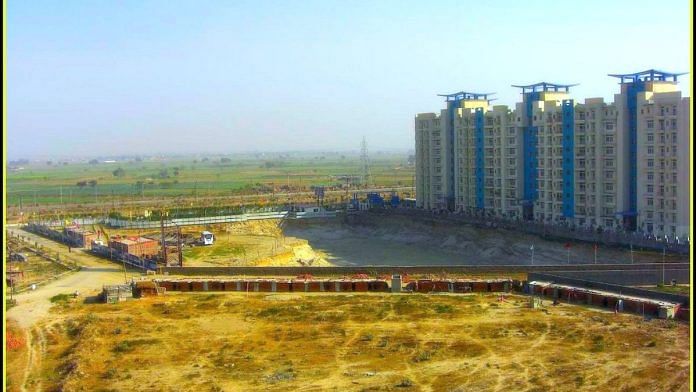New Delhi: Setting up city-level economic development councils (CEDC) to leverage economic potential of cities, empowering district authorities to check on urban sprawl and planning for rural to urban transition are among the key recommendations of the Centre-appointed high-level committee on urban planning, ThePrint has learnt.
The committee—setup by the Ministry of Housing and Urban Affairs (MoHUA) in 2022 to recommend urban planning reforms—submitted its second report, ‘Pathways to Amrit Kaal: Envision and realizing a new future for Indian cities’, to the ministry last month.
In its 186-page report, it has recommended a slew of measures, including amendments to central and state legislations, and to strengthen the urban planning framework and address the issue of unregulated development in urban and peri-urban areas.
ThePrint has assessed the contents of the report.
In its first report submitted in April last year, the panel addressed issues plaguing cities which are struggling to cope with rapid urbanisation. One of the key recommendations was to set up a national authority on urban and regional planning that would be headed by the prime minister to leverage the economic potential of cities.
“The second report, which we submitted to the ministry last month, provides the framework for implementation of key urban reforms. While we have suggested a slew of measures, a crucial recommendation is about creating a city economic development mission under the patronage of the PM and for a complete transformation of cities,” Keshav Varma, chairman of the committee, told ThePrint.
“CEDCs should be set up in cities with a population of one million and above. It shouldn’t be an advisory council, but ensure active involvement of the business community and professionals, among others, in decision making,” he added.
“The NITI Aayog is already talking about cities as growth hubs. The committee has recommended setting up of CEDCs and putting in efforts to reactivate the planning framework,” a senior ministry official told ThePrint.
ThePrint has reached the ministry for a comment via WhatsApp messages. This report will be updated if and when a response is received.
The role of a CEDC will be to develop economic development strategies for the city with an objective of creating “employment and enhancing skills and stimulating local economic development”, the report says.
The committee has also recommended urban reforms for Assam, Gujarat, Kerala, Haryana, Uttarakhand, Rajasthan, Tamil Nadu, Uttar Pradesh, and Jammu and Kashmir. This was done in consultation with their governments.
With nearly 50 percent of the country’s population expected to live in cities by 2050 (according to a 2021 NITI Aayog report), urban development experts have been emphasising the need for regulating urban development.
To address the issue of unregulated development of peri-urban areas and fast-paced transition of rural areas to urban, and check on urban sprawl, the committee has recommended that the Centre consider incentivising brownfield development (or redevelopment of existing areas).
Also Read: 8 crore MGNREGS workers deleted in 2 yrs. Centre’s Budget cuts, tech push to blame — NGO report
Empowering district authorities for better planning
A comprehensive and strategic approach to economic development is essential to unlock the economic potential of cities, the report says.
Cities should prepare detailed economic development plans which dovetail into the master plan and integrate various aspects of urban planning, infrastructure and social needs with economic growth strategies, it suggests.
There should be a “shelf of bankable, investible grade projects” ready to attract investment, the report says.
The committee also recommended empowering district authorities by appointing a district urban development officer under the district collector.
The district urban development officer’s key role and functions will include overseeing and monitoring the performance of civic bodies, preparing development plans for smaller municipalities and transition villages (those which are seeing a transition from rural to urban) and facilitating coordination and partnership for promotion of the region, it says.
For instance, Gujarat has created a post called regional commissioner of the municipality, according to the report. The regional commissioners will oversee planning and development of Tier-2 and Tier-3 cities.
The committee has recommended that a metropolitan/municipal infrastructure pipeline and a metropolitan/municipal asset monetisation pipeline be developed on the lines of National Infrastructure Pipeline (NIP) and National Monetisation Pipeline (NMP) in consultation with the respective CEDCs.
Metro rails only in cities with 5 million-plus population
Currently, over 900 km of metro network is operational in the country, and nearly 700 km are under various stages of construction. In the past few years, there has been an increase in demand from various states for metro rail projects in Tier-2 cities.
The committee has pushed for prioritising bus transport over metro rail projects in cities and establishment of a Unified Metropolitan Transport Authority (UMTA) in all major cities.
“UMTA should be autonomous and professionally managed….We also recommend metro rail only in cities above 5 million population. Metro rail DPRs should include last mile connectivity including neighbourhood drop bus DPRs,” the report said.
(Edited by Radifah Kabir)
Also Read: 3 years on, 30% of rural land parcels have Bhu-Aadhaar. Centre pushes for completion by 2026






